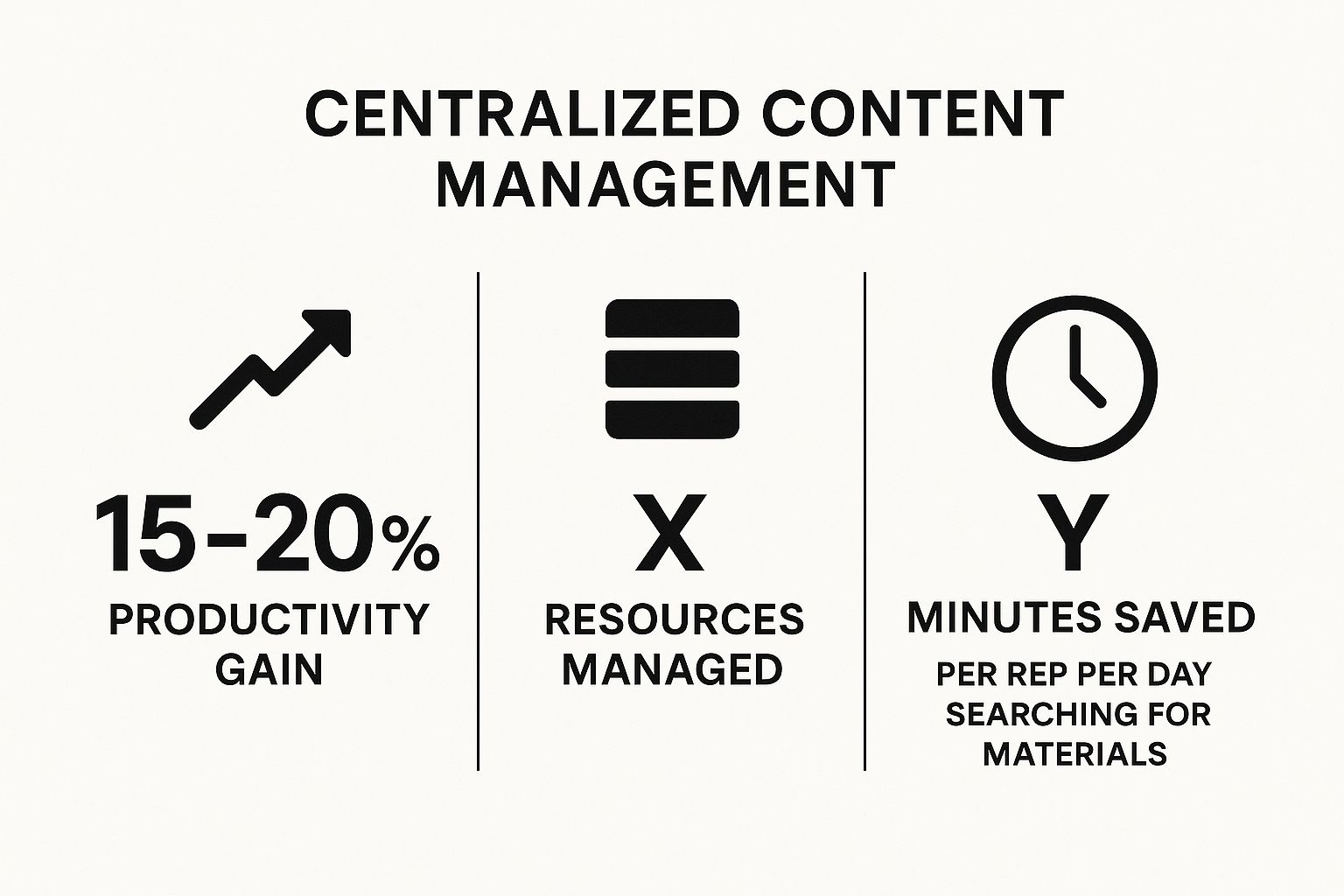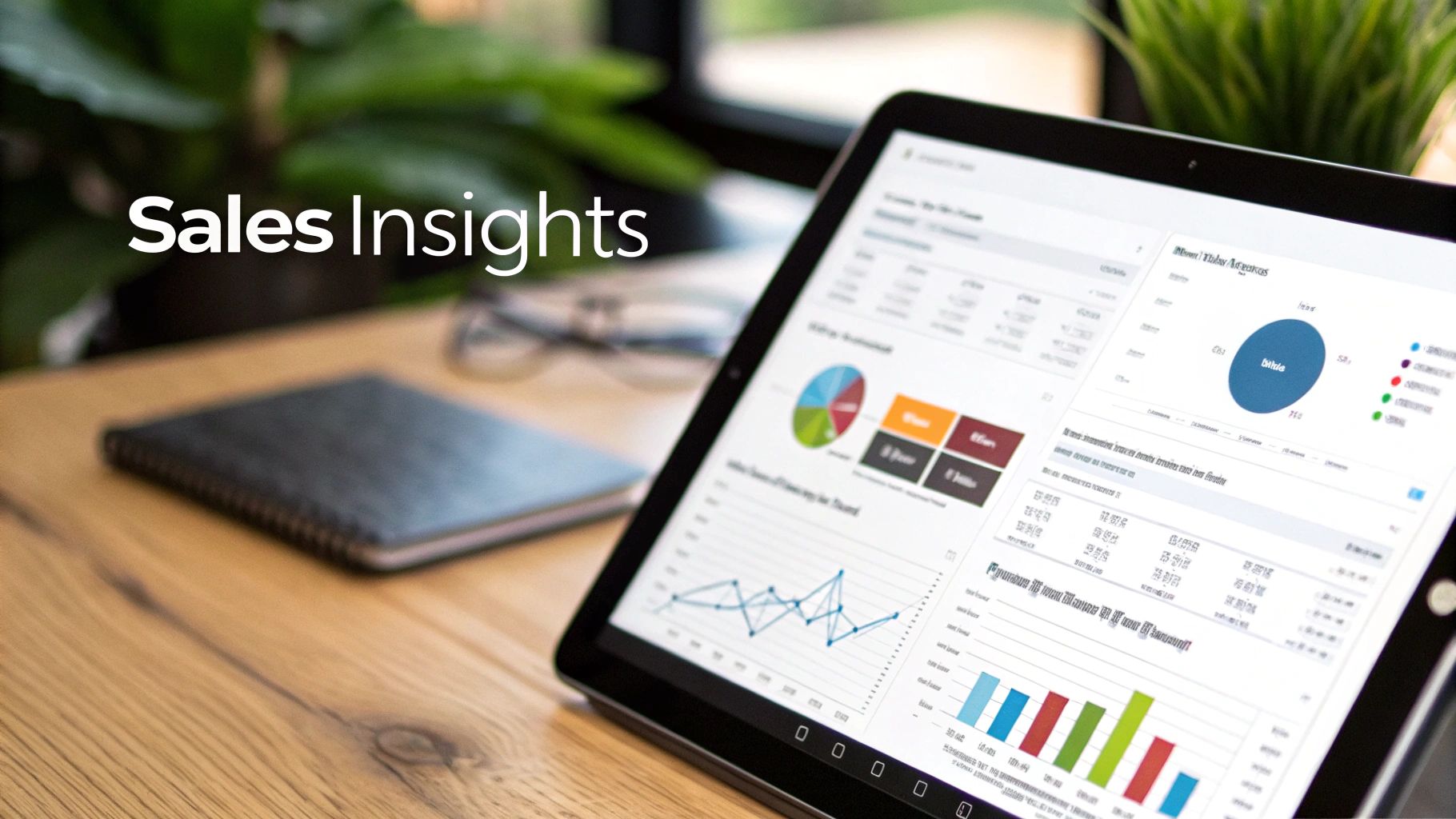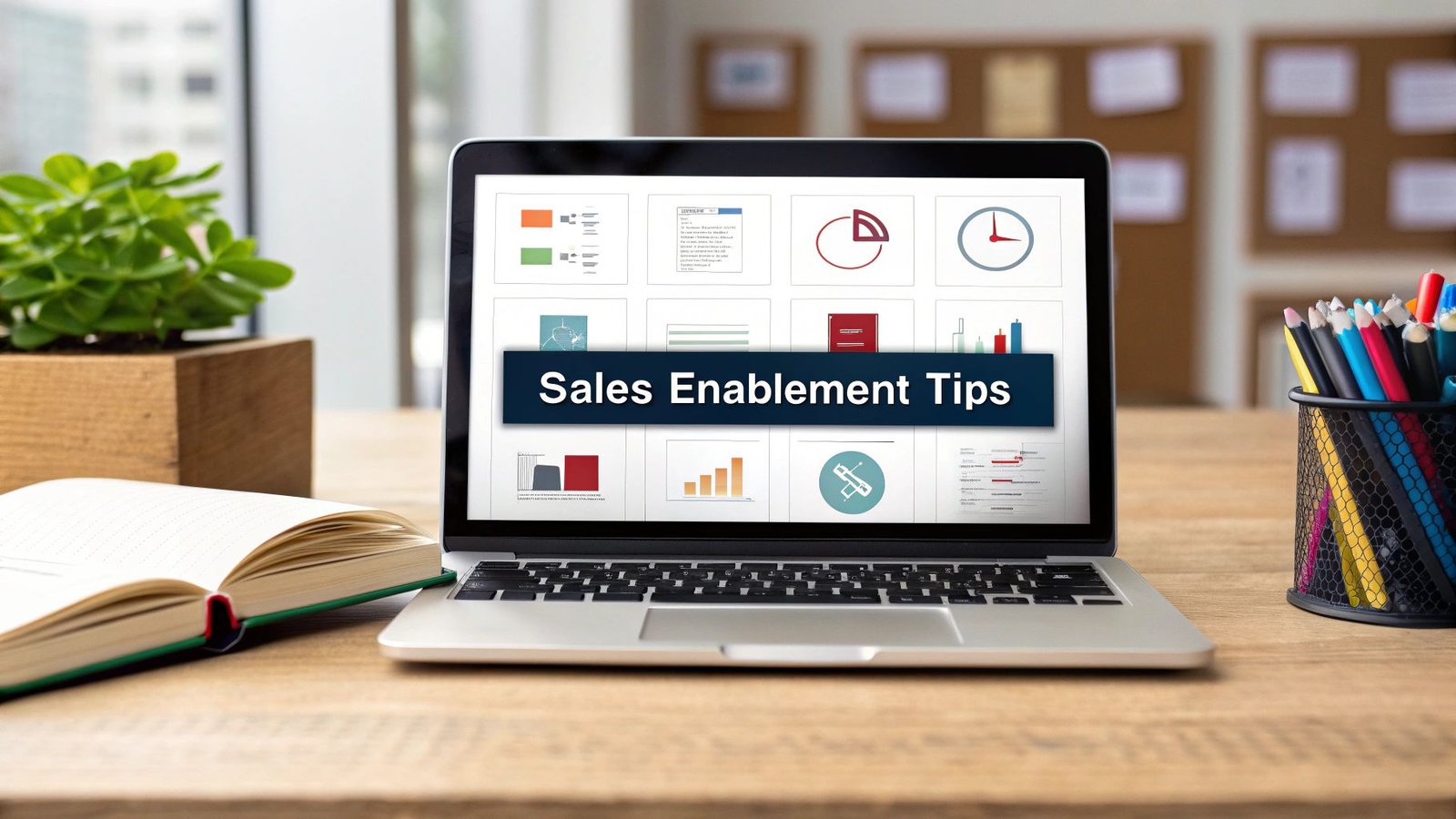In a competitive SaaS market, closing deals requires more than just a talented sales team; it demands a robust, strategic framework that empowers them at every stage of the buyer's journey. This is the core function of sales enablement: providing sellers with the precise content, training, tools, and data-driven insights they need to engage prospects effectively and efficiently. Done right, a strong sales enablement strategy becomes the engine of revenue growth, transforming potential into performance and turning conversations into conversions.
This guide moves beyond generic advice to deliver a comprehensive roundup of actionable sales enablement best practices. We will dissect the essential components that high-performing sales organizations use to consistently outperform their targets. You will learn not just what to do, but how to implement these strategies within your own team, with a specific focus on the nuances of navigating the Nordic SaaS market.
We'll cover critical pillars such as centralizing your content for easy access, forging a powerful alignment between your sales and marketing departments (Smarketing), and implementing a continuous training program that keeps skills sharp. Furthermore, we will explore the importance of leveraging analytics for smarter decision-making, building dynamic sales playbooks, and optimizing your technology stack to eliminate friction. Each practice is designed to be a building block, helping you construct a more agile, informed, and successful sales operation. This article provides the blueprint for equipping your team to not only meet their quotas but to create lasting customer relationships and drive sustainable business growth.
1. Content Centralization and Management
A cornerstone of any effective sales enablement strategy is creating a single source of truth for all sales-related content. Content centralization involves establishing a dedicated, organized repository where sales representatives can easily find, use, and share approved materials like case studies, pitch decks, product sheets, and proposal templates. When sales teams waste time searching for assets across scattered drives or outdated internal wikis, they lose valuable selling time and risk sending inconsistent or incorrect information to prospects.
This practice directly addresses one of the biggest productivity drains for sales teams. By implementing a centralized system, you ensure every rep has immediate access to the most current and compelling content, reinforcing consistent messaging across all customer interactions. This is a foundational element of sales enablement best practices because it equips your team with the right tools at the right moment in the buyer’s journey, empowering them to have more meaningful and effective conversations.
Key Benefits and Implementation
Leading platforms like Seismic and Highspot have popularized this approach, demonstrating its power in large-scale sales organizations. For instance, a company like Microsoft uses a centralized playbook system to ensure its global sales force delivers a unified message, while HubSpot’s Sales Hub offers a built-in content library to streamline this process for teams of all sizes. The goal is to eliminate friction and empower reps to focus on selling, not searching.
To implement this effectively:
- Establish a clear taxonomy: Use logical folder structures and consistent naming conventions (e.g., [ContentType][ProductName][Date]).
- Implement version control and archiving: Set expiration dates on time-sensitive content to automatically archive outdated materials, ensuring reps only use fresh, relevant information.
- Enable powerful search: Incorporate tags, metadata, and advanced filtering options to help reps find the exact asset they need in seconds.
- Analyze usage data: Regularly audit which content is used most frequently and which assets correlate with closed deals. Use these insights to refine your content strategy.
Pro Tip: Integrate your centralized content repository directly into your CRM. This allows sales reps to access, customize, and share approved content without ever leaving the platform where they manage their deals, significantly boosting workflow efficiency and adoption.
The following infographic highlights key data points demonstrating the significant impact of a well-managed content repository on sales team efficiency.

These statistics underscore a clear ROI, showing that centralizing content isn't just an organizational task but a direct driver of significant productivity gains and time savings for every sales representative.
2. Sales and Marketing Alignment (Smarketing)
A critical pillar of modern sales enablement best practices is the strategic alignment of sales and marketing, often called "Smarketing." This practice involves creating formal processes, shared goals, and open communication channels to ensure both teams work as a single, cohesive unit toward revenue targets. When sales and marketing operate in silos, the result is often misqualified leads, inconsistent messaging, and wasted resources, creating friction that directly impacts the bottom line.

True alignment means marketing understands what a high-quality lead looks like to sales, and sales effectively uses the content and campaigns marketing produces. By establishing shared definitions for terms like Marketing Qualified Lead (MQL) and Sales Qualified Lead (SQL), organizations can build a seamless handoff process. This collaborative approach ensures that prospects receive a consistent, relevant experience from their first marketing touchpoint to their final conversation with a sales rep, dramatically improving conversion rates and pipeline velocity.
Key Benefits and Implementation
Pioneered by thought leaders like Brian Halligan and Dharmesh Shah of HubSpot, smarketing has become a foundational strategy for high-growth companies. For example, Adobe’s integrated go-to-market approach ensures its marketing campaigns are designed with direct input from sales leadership, resulting in highly relevant pipeline generation. The goal is to create a symbiotic relationship where marketing fuels sales with quality leads and insights, and sales provides marketing with frontline feedback to refine strategies.
To implement this effectively:
- Establish a Service Level Agreement (SLA): Formally document the responsibilities of each team. Define marketing's monthly MQL commitment and sales' commitment to follow up within a specific timeframe.
- Create shared buyer personas: Collaboratively develop and agree upon Ideal Customer Profiles (ICPs) and buyer personas to ensure both teams are targeting the same audience with a unified message.
- Use shared dashboards and metrics: Build a central dashboard in your CRM or BI tool that tracks key metrics like lead volume, MQL-to-SQL conversion rate, and pipeline contribution, providing total visibility for both teams.
- Hold regular alignment meetings: Schedule weekly or bi-weekly "smarketing" meetings with stakeholders from both departments to review performance, discuss challenges, and plan upcoming initiatives.
Pro Tip: Structure compensation and bonus plans around shared revenue goals rather than separate departmental KPIs. When marketers are partially bonused on closed-won deals and sales teams are incentivized to provide quality feedback, it fosters a powerful "one team, one dream" mentality.
3. Continuous Sales Training and Skill Development
A one-time onboarding session is not enough to create a high-performing sales team. Continuous sales training is a strategic commitment to ongoing skill development, ensuring reps consistently adapt to evolving market conditions, product updates, and buyer behaviors. This involves implementing structured, recurring learning programs that cover everything from advanced sales methodologies and product knowledge to soft skills like negotiation and active listening. It moves beyond initial training to build a culture of perpetual improvement.
This commitment to lifelong learning is one of the most critical sales enablement best practices because it directly impacts a rep’s ability to stay competitive and effective. Markets change, products get updated, and yesterday's successful pitch might fall flat tomorrow. By providing ongoing education through formats like microlearning, role-playing, and peer coaching, you equip your team to handle any sales scenario with confidence and competence, turning good salespeople into great ones.

Key Benefits and Implementation
Methodologies like those developed by Neil Rackham (SPIN Selling) and Matthew Dixon (The Challenger Sale) highlight the need for specific, trainable skills. Tech giants like IBM and Oracle have long institutionalized this with dedicated sales universities and certification programs that ensure a high standard of expertise across their organizations. The goal is to make learning an integrated part of the sales role, not a separate, infrequent event.
To implement this effectively:
- Use spaced repetition: Reinforce key concepts over time with short, frequent training modules (microlearning) to improve long-term knowledge retention.
- Incorporate real-world scenarios: Move beyond theory with role-playing exercises based on actual customer interactions and recorded sales calls to build practical skills.
- Make training accessible: Provide on-demand training materials that are mobile-friendly, allowing reps to learn whenever and wherever it is most convenient for them.
- Measure the impact: Track how training completion correlates with key sales metrics like quota attainment, deal size, and sales cycle length to prove ROI and refine your programs. These skills are fundamental to enhancing your outreach and are closely related to effective sales prospecting techniques.
Pro Tip: Create a peer-to-peer coaching program where top performers share their winning strategies and techniques with the rest of the team. This not only scales your training efforts but also fosters a collaborative culture and validates best practices from within.
The following video from sales expert Victor Antonio discusses the importance of continuous practice and preparation in mastering the art of selling.
By investing in continuous development, you empower your sales team to not only meet their current targets but also to anticipate and adapt to future challenges, ensuring sustainable success for the entire organization.
4. Data-Driven Sales Analytics and Insights
Harnessing the power of data is a transformative sales enablement best practice that separates high-performing teams from the rest. Data-driven sales analytics involves systematically collecting, analyzing, and acting upon sales data from CRMs, conversation intelligence platforms, and other sources. This process turns raw numbers into actionable insights that inform strategy, pinpoint growth opportunities, and highlight areas for individual and team improvement. Instead of relying on intuition, sales leaders can make objective decisions to optimize processes and coach reps more effectively.

This approach directly empowers sales teams to understand what truly drives success. By analyzing metrics like conversion rates by stage, deal velocity, and customer interaction patterns, you can identify winning behaviors and replicate them across the team. This is a crucial component of modern sales enablement because it provides a clear, evidence-based path to refining sales motions, improving forecast accuracy, and ultimately accelerating revenue growth.
Key Benefits and Implementation
Pioneers like Marc Benioff have built entire ecosystems around this principle with platforms like Salesforce Einstein Analytics, which uses AI to uncover trends and predict outcomes. Similarly, Gong.io, co-founded by Amit Bendov, revolutionized sales coaching by analyzing sales conversations at scale to reveal what top performers say and do. These tools demonstrate the power of moving from descriptive analytics (what happened) to predictive and prescriptive analytics (what will happen and what to do about it).
To implement this effectively:
- Focus on impactful metrics: Start by tracking key performance indicators (KPIs) that directly impact revenue, such as lead-to-opportunity conversion rate, sales cycle length, and average deal size.
- Ensure data hygiene: Regularly audit your CRM data to correct inaccuracies and enforce consistent data entry practices. High-quality insights depend on high-quality data.
- Train your team on interpretation: Equip sales managers and reps with the skills to read dashboards and understand what the analytics are telling them about their performance and opportunities.
- Use predictive models: Leverage tools with predictive capabilities to identify at-risk deals, forecast sales more accurately, and prioritize high-potential leads.
Pro Tip: Create role-specific dashboards. An individual sales rep needs to see their personal pipeline health and activity metrics, while a sales leader needs a high-level view of team performance, forecast accuracy, and overall revenue trends. Customizing views makes the data more relevant and actionable for everyone.
5. Sales Playbook Development and Implementation
A powerful sales enablement best practice involves creating comprehensive sales playbooks that serve as a go-to guide for your entire team. A sales playbook is a standardized document outlining your sales processes, methodologies, buyer personas, talk tracks, and best practices for specific scenarios. It's the "how-to" manual that equips reps with a clear, repeatable framework for engaging prospects, handling objections, and closing deals effectively. Without one, reps are left to improvise, leading to inconsistent messaging and a longer ramp-up time for new hires.
This practice is fundamental because it codifies what works and scales that knowledge across the entire organization. By documenting proven strategies and tactics, you transform tribal knowledge into a structured, accessible asset. This ensures that every rep, from the newest hire to the seasoned veteran, is aligned on the most effective approach for each stage of the buyer's journey. A well-developed playbook standardizes excellence, reducing variability in performance and creating a more predictable sales engine.
Key Benefits and Implementation
Sales leaders like Anthony Iannarino and Mark Roberge have long championed the power of structured playbooks to accelerate growth. For example, Salesforce equips its account executives with detailed playbooks for different industries and account sizes, while HubSpot built its entire growth model on a meticulously documented inbound sales methodology playbook. These guides provide clarity and confidence, enabling reps to navigate complex sales cycles with proven tactics.
To implement this effectively:
- Keep playbooks dynamic: Treat them as living documents, regularly updating them with new insights, success stories, and market feedback.
- Customize for context: Develop different plays for various roles (SDR vs. AE), customer segments, or product lines to ensure maximum relevance.
- Include proven scripts and templates: Provide battle-tested talk tracks, email templates, and guides for handling common objections and navigating competitive situations.
- Integrate qualification criteria: Embed clear guidelines, such as those found in different sales qualification frameworks, to help reps prioritize high-value leads.
Pro Tip: Make your sales playbook interactive and digital. Instead of a static PDF, use a platform that allows for easy searching, video examples, and direct links to relevant content in your centralized repository. This boosts engagement and ensures reps can find what they need in the moment.
6. Technology Stack Integration and Optimization
A modern sales enablement strategy is powered by a well-orchestrated technology stack. Technology stack integration and optimization involve strategically selecting, connecting, and refining sales tools to create a seamless workflow. This process eliminates manual tasks, enhances productivity, and provides a unified view of the entire sales cycle. When systems like a CRM, sales engagement platform, and conversation intelligence tool operate in silos, reps are forced into time-consuming administrative work, data becomes fragmented, and valuable insights are lost.
This practice is one of the most critical sales enablement best practices because it builds the operational backbone for the entire sales team. By ensuring tools communicate with each other effectively, you automate data flow, reduce friction, and empower reps with the right information at the right time. A deeply integrated stack transforms individual tools from simple utilities into a powerful, unified system that drives efficiency, improves data accuracy, and provides leadership with a clear, holistic view of performance.
Key Benefits and Implementation
Sales leaders like Kyle Porter of SalesLoft and Trish Bertuzzi have long championed the power of an integrated tech stack to scale sales development. For example, a common high-performance stack integrates Salesforce (CRM), Outreach (sales engagement), and Gong (conversation intelligence). This allows reps to execute multi-channel outreach in Outreach, have all activities and call recordings automatically logged in Salesforce, and use Gong to analyze conversation data linked directly to CRM opportunities. This eliminates manual data entry and provides a complete picture of every deal.
To implement this effectively:
- Audit your current stack: Identify overlapping functionalities and eliminate redundant or underutilized tools to reduce costs and complexity.
- Prioritize seamless integrations: Focus on native integrations that eliminate double data entry and ensure data flows automatically between critical platforms.
- Provide comprehensive training: Thoroughly train users not just on individual tools, but on how to leverage the integrated workflow to maximize their efficiency. For more insights into this, you can learn more about developing a comprehensive CRM strategy.
- Regularly review ROI: Continuously analyze tool usage and its impact on key sales metrics to ensure your technology investments are delivering tangible results.
Pro Tip: Map your technology stack directly to your sales process. Each tool should have a clear purpose tied to a specific stage of the buyer's journey, from prospecting with LinkedIn Sales Navigator to closing deals with PandaDoc, ensuring there are no gaps or overlaps in your workflow.
7. Customer Success and Feedback Integration
A truly mature sales enablement strategy extends beyond the initial sale by integrating insights from the customer success team. Customer success and feedback integration involves creating a formal communication loop where post-sale data, customer health scores, and user feedback are systematically shared with the sales team. This practice transforms sales from a transactional function into the first step of a long-term, value-driven customer relationship.
This approach directly combats churn and identifies expansion opportunities by arming sales reps with a deep understanding of what makes a customer successful long-term. Instead of focusing solely on closing a deal, reps learn to identify ideal customer profiles based on post-sale outcomes. This is one of the most impactful sales enablement best practices because it aligns sales motions with real-world customer value, leading to better-fit customers, higher retention, and more authentic sales conversations.
Key Benefits and Implementation
Pioneered by customer success thought leaders like Nick Mehta of Gainsight, this methodology is now central to high-growth SaaS companies. For instance, Slack analyzes product usage data to inform its enterprise sales team about which accounts are prime for expansion, while Zoom uses customer health scores to proactively engage with accounts. The objective is to use post-sale intelligence to refine pre-sale strategies, ensuring the sales team brings in customers who are set up for success from day one.
To implement this effectively:
- Establish a formal feedback loop: Schedule regular meetings between sales and customer success teams to discuss common customer challenges, success stories, and reasons for churn.
- Share customer health scores: Integrate data from platforms like Gainsight or Catalyst into your CRM, giving account executives visibility into the post-sale health of their closed deals.
- Incorporate success stories into training: Use real customer wins and testimonials from the success team to build more compelling and realistic sales training scenarios.
- Refine sales messaging with user feedback: Analyze post-implementation surveys and support tickets to identify key value propositions and pain points that resonate most with active users, then update pitch decks and discovery questions accordingly.
Pro Tip: Create a “Voice of the Customer” document that is jointly owned by sales and customer success. This living document should summarize key feedback, feature requests, and success metrics, serving as a shared resource to keep both teams aligned on delivering customer value.
8. Personalized Buyer Journey Mapping
A pivotal element of modern sales enablement best practices is shifting from a seller-centric process to a buyer-centric one through personalized buyer journey mapping. This involves creating a detailed, visual representation of how different buyer personas navigate their purchasing decision. It charts every touchpoint, from initial awareness to final purchase and beyond, identifying the specific questions, challenges, and information needs that arise at each stage. When sales teams understand this journey, they can stop pushing a generic script and start guiding prospects with relevant, timely, and valuable interactions.
This practice directly empowers sales reps to become trusted advisors rather than just vendors. By mapping the journey, you equip your team with the empathy and insight needed to anticipate a buyer's next move and proactively address their concerns. This is a crucial strategy because it aligns sales actions with the customer's actual decision-making process, ensuring that every engagement is contextually relevant and moves the deal forward in a natural, supportive way.
Key Benefits and Implementation
This methodology has been championed by experts like Adele Revella of the Buyer Persona Institute and is used effectively by major enterprise organizations. For example, a company like Adobe maps distinct journeys for its enterprise buyers, understanding that the path for a CMO (economic buyer) is vastly different from that of a marketing manager (champion). This allows them to tailor content and conversations specifically to the stakeholder they are engaging, dramatically increasing relevance and impact.
To implement this effectively:
- Interview existing customers: Speak with both new and long-standing clients to understand the real steps, pains, and "aha" moments they experienced during their buying process.
- Map content and tools to each stage: Align specific assets (e.g., case studies for the consideration stage, ROI calculators for the decision stage) to points in the journey where they will be most effective.
- Include multiple persona journeys: Create separate but interconnected maps for different stakeholders, such as the end-user, the economic buyer, and the technical validator.
- Update maps with win/loss analysis: Regularly review closed-won and closed-lost deals to identify patterns. Use these insights to refine and update your journey maps to reflect current market realities.
Pro Tip: Integrate your buyer journey maps into your sales playbook and CRM. Create fields or tags that allow reps to identify a prospect's current stage in the journey, which can trigger automated recommendations for the next best action or the most relevant piece of content to share.
9. Sales Coaching and Performance Management
Effective sales enablement extends beyond content and tools; it involves the systematic development of your sales team’s skills. Sales coaching and performance management is the practice of using data-driven insights, structured one-on-ones, and targeted skill development to elevate individual and team performance. Instead of relying on infrequent, high-level reviews, this approach creates a continuous feedback loop that helps reps refine their techniques and overcome specific challenges.
This practice is one of the most critical sales enablement best practices because it directly impacts the human element of selling. By implementing a formal coaching program, you transform managers from simple overseers into strategic coaches who actively foster growth. This not only boosts quota attainment but also improves morale and reduces churn by showing reps a clear path for professional development and success within the organization.
Key Benefits and Implementation
Pioneering platforms like Gong and Chorus.ai have revolutionized this space by using AI to analyze call recordings, providing objective data for targeted coaching sessions. These tools can pinpoint moments where a rep excelled or struggled, turning every sales call into a learning opportunity. Experts like Keith Rosen, author of Coaching Salespeople Into Sales Champions, have long advocated for this structured approach, emphasizing that coaching is about asking the right questions, not just giving answers.
To implement this effectively:
- Use call recordings for objective feedback: Leverage conversation intelligence tools to review actual customer interactions, moving coaching discussions from subjective opinions to data-backed analysis.
- Focus on specific, actionable improvements: Instead of saying “be more confident,” focus on tangible behaviors like “ask two more discovery questions before pitching the solution.”
- Set clear expectations and success metrics: Define what successful outcomes look like for each skill being developed, whether it’s a higher conversion rate on discovery calls or a shorter sales cycle.
- Provide regular, positive reinforcement: Acknowledge improvements and celebrate small wins to build confidence and motivate reps to continue their development journey.
Pro Tip: Create a “game film” library of best-practice call recordings. Tag and organize examples of top performers handling objections, running discovery calls, or closing deals. This creates a powerful, on-demand training resource for the entire team.
Sales Enablement Best Practices Comparison
| Item | Implementation Complexity 🔄 | Resource Requirements ⚡ | Expected Outcomes 📊 | Ideal Use Cases 💡 | Key Advantages ⭐ |
|---|---|---|---|---|---|
| Content Centralization and Management | Medium – requires upfront setup & ongoing updates | Moderate – tech platform and maintenance | Increases sales productivity by 15-20% | Organizations needing consistent messaging & quick access to content | Reduces duplication, improves governance, boosts productivity |
| Sales and Marketing Alignment (Smarketing) | High – cultural change & executive buy-in needed | Moderate – time for meetings and alignment tools | 208% more revenue from marketing efforts, 38% higher win rates | Companies facing sales-marketing silos needing shared goals | Improves lead quality, frictionless handoff, consistent experience |
| Continuous Sales Training and Skill Development | High – ongoing development and delivery effort | High – content creation, training time, certification costs | Improved win rates and sales performance over time | Firms aiming to upskill reps and adapt to market changes | Boosts engagement, ensures methodology adoption, skill growth |
| Data-Driven Sales Analytics and Insights | Medium-High – data setup, quality, and analysis expertise | Moderate to High – analytics tools and training | Better forecast accuracy and optimized sales process | Sales teams wanting actionable insights and predictive forecasting | Enables data-driven decisions, identifies opportunities, improves accuracy |
| Sales Playbook Development and Implementation | Medium – detailed initial creation and updates required | Moderate – content development and training | Standardized sales approach, reduced ramp time | Sales teams needing consistent processes and coaching framework | Standardizes approach, shortens ramp, improves consistency |
| Technology Stack Integration and Optimization | High – complex integrations and training | High – software licenses and change management | 15-20% increase in sales productivity | Organizations scaling sales with multiple tech tools | Increases productivity, reduces errors, improves pipeline visibility |
| Customer Success and Feedback Integration | Medium – cross-functional collaboration required | Moderate – feedback systems and training | 12% higher customer retention | Sales teams aiming to reduce churn and grow accounts | Improves lifetime value, reduces handoff friction, identifies expansion |
| Personalized Buyer Journey Mapping | Medium – requires deep customer research and updates | Moderate – research and mapping tools | 18% revenue growth increase | Businesses targeting persona-specific sales effectiveness | Improves relevance, shortens cycles, aligns sales with customer needs |
| Sales Coaching and Performance Management | High – ongoing coaching and manager time intensive | High – trained coaches, tools for recording and tracking | Accelerated skill development and performance improvement | Organizations investing in individual rep growth and retention | Improves performance, retention, consistent standards |
Final Thoughts
Navigating the landscape of modern SaaS sales requires more than just a great product and a talented sales team. It demands a strategic, cohesive framework that empowers every seller to perform at their absolute peak. This is the core purpose of implementing robust sales enablement best practices. Throughout this guide, we've explored the critical pillars that transform disorganized sales efforts into a high-powered, revenue-generating machine. From centralizing your content and aligning marketing with sales, to leveraging data-driven insights and embedding continuous coaching, each practice serves as a vital cog in a much larger system.
The journey to sales enablement excellence is not a one-time project but an ongoing commitment to refinement and adaptation. The strategies we've discussed are not isolated tactics; they are interconnected components of a holistic ecosystem designed to make selling simpler, more effective, and more rewarding.
Key Takeaways: Your Blueprint for Success
To truly embed these concepts, let's distill the most crucial takeaways from our discussion on sales enablement best practices:
- Centralization is Non-Negotiable: A single source of truth for all sales content eliminates friction, ensures message consistency, and saves your reps countless hours. If your team is still hunting for materials in shared drives or old email threads, this is your first priority.
- Alignment Drives Acceleration: The traditional divide between sales and marketing is a relic of the past. True alignment, or "smarketing," means shared goals, integrated workflows, and a unified voice that guides the buyer from initial awareness to final purchase.
- Data Over Intuition: Your CRM and sales tools are goldmines of information. The most successful sales organizations are those that harness this data to understand what's working, identify bottlenecks, and make informed decisions that directly impact performance.
- Empowerment Through Enablement: The ultimate goal is to empower your reps. This means providing them with the right content, the right training, and the right tools at the exact moment they need them. It's about removing obstacles so they can focus on what they do best: building relationships and closing deals.
Your Actionable Next Steps
Feeling inspired but unsure where to begin? Start small and build momentum. Choose one or two of these sales enablement best practices that address your team's most significant pain points.
- Conduct a Content Audit: Where does your sales content live? Is it up-to-date, on-brand, and easy to find? Begin the process of creating a centralized content repository.
- Schedule a "Smarketing" Workshop: Get sales and marketing leaders in a room to define a shared Service Level Agreement (SLA) and map out a collaborative content creation process.
- Review Your Tech Stack: Are your tools integrated and serving their purpose? Identify any redundancies or gaps that are hindering, rather than helping, your sales process.
Mastering these concepts is no longer a competitive advantage; it's a fundamental requirement for survival and growth in the crowded SaaS market. By systematically implementing these sales enablement best practices, you are not just supporting your sales team, you are building a scalable, predictable, and resilient revenue engine for your entire organization. The investment you make in enabling your sellers today will pay dividends in quota attainment, customer satisfaction, and long-term business success tomorrow.
Ready to supercharge your sales enablement efforts with precision-targeted data? The best strategies are powered by the best leads. Nordic Lead Database provides SaaS sales teams with an unparalleled, continuously updated database of decision-makers across the Nordic region, ensuring your empowered sellers are connecting with the right people at the right time. Visit Nordic Lead Database to see how our data can fuel your revenue growth.
